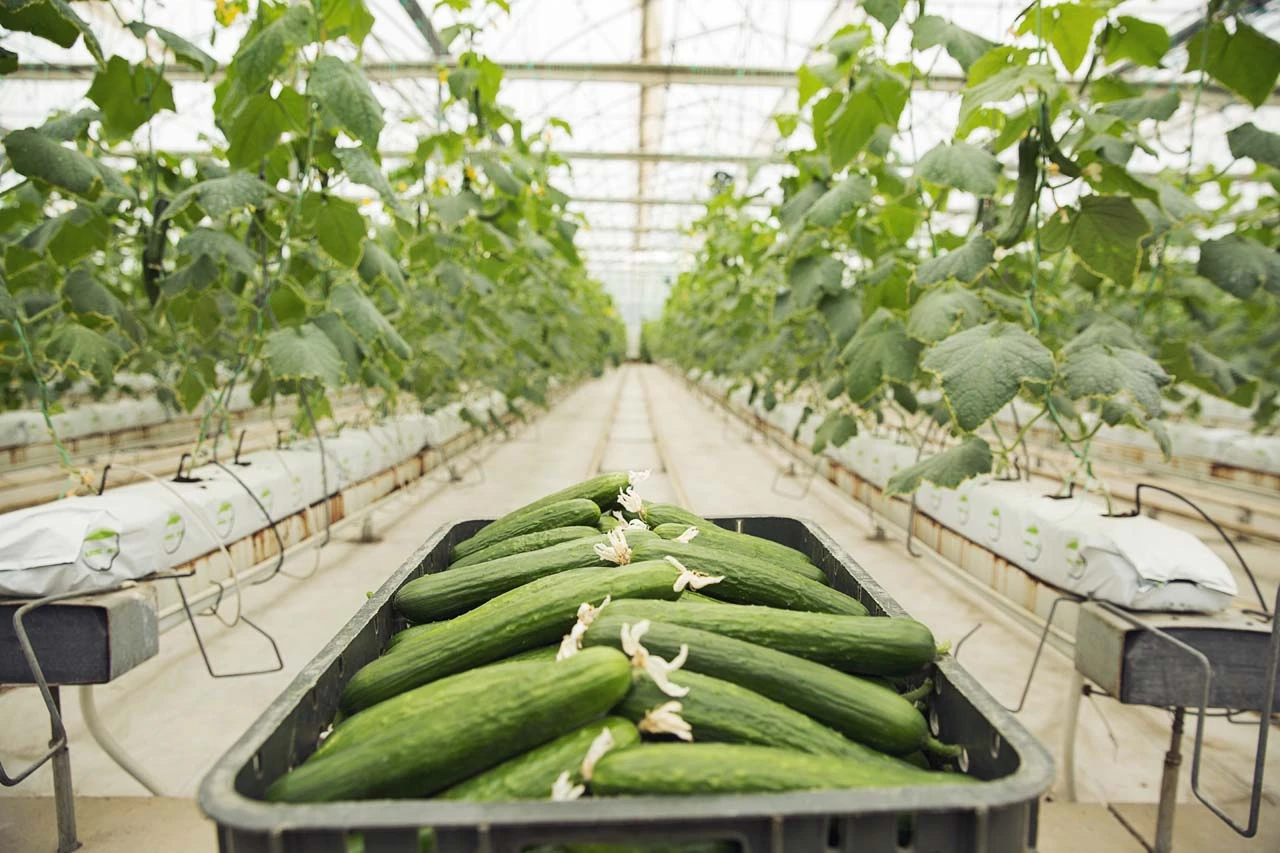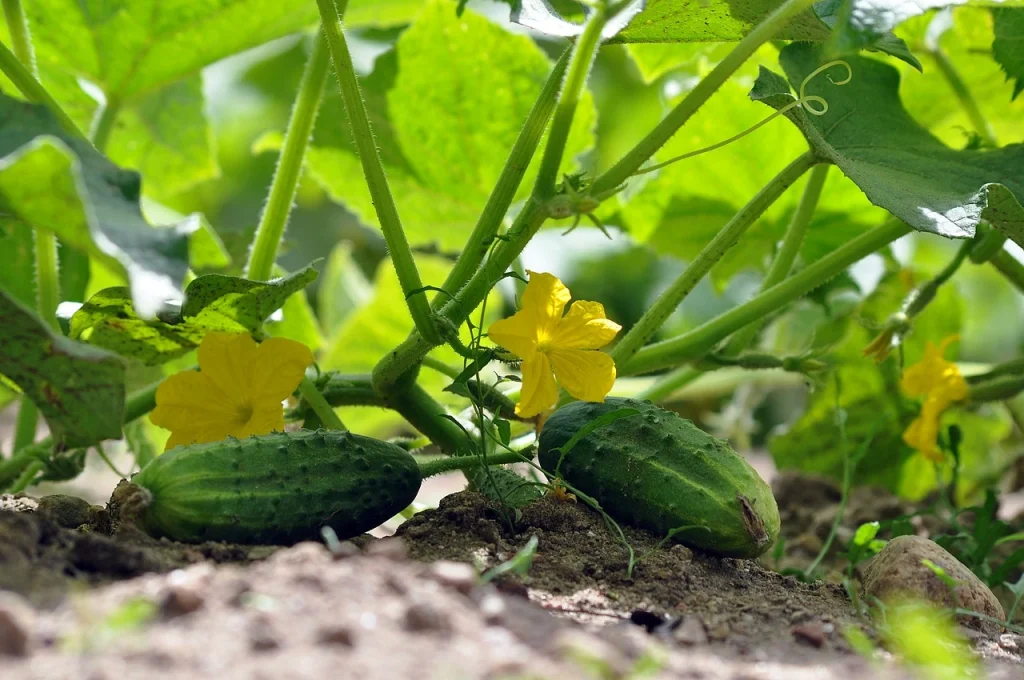Cucumber Grown in the US in Winters
Is it possible to grow cucumbers in the US during the winter months? Cucumbers belong to a family of vegetables that thrive in warm temperatures, growing best when both days and nights are warm. Although cucumbers aren’t typically winter vegetables, they can still be produced in winters if properly cared for. The ideal temperature for cucumber growth is 75-85 degrees Fahrenheit. However, in most parts of the continental US, cucumbers cannot be grown outside during winters due to the cold, which can damage the plant and cause decay, pitting, and chilling injury.
Studies show that cucumbers cannot grow below 60 degrees Fahrenheit, so maintaining an optimal temperature is crucial for their growth. If you don’t live in the warmest zones of the US, an indoor growing system is necessary to plant cucumbers. Alternatively, you can grow them in a greenhouse, especially for industrial-scale production. There are several winter cucumber varieties suitable for traditional and high-wire plantations. Continue reading to learn more about “Cucumber Grown in the US in Winters” and much more in this article.
How to Grow Cucumbers Indoors?

Cucumber Grown in the US in Winters can be fun and you can have this nutritious treat all year round. Cucumbers can’t tolerate extreme cold when planted outside. To grow this plant during winters, you must set up an indoor growing system. It can be challenging for a beginner, especially in the beginning, but learn to mastering the tricks. Here are some simple steps to help you grow cucumbers indoors and achieve optimal results. Let’s explore them one by one.
- Choose hybrid cucumber seeds.
It is best to choose hybrid cucumber seeds that don’t require pollination. Conserve the space by picking a dwarf variety of cucumbers. - Select an enlarged pot.
Cucumbers need lots of room to grow, even if you have bought a dwarf variety. You can choose enlarged pots or grow them in hanging pots for optimal growth. - Aid drainage in the selected pot.
Keep the roots of the plant from getting soggy and aid drainage in the selected pot. You can add gravel, clay shards, or small stones to the bottom of the container. You can also place a small pot with drainage holes in the middle of the large one if you do not have these materials at the bottom. - Mix potting soil and compost.
Dirt from your garden will increase the risk of getting unwanted pests indoors. To avoid that, mix potting soil and compost (50% each) and fill your planting pot with these. - Plant 4-5 seeds appropriately.
The next step is to plant 4-5 seeds that must be around 12mm deep. Plant them with space between them (around half inch apart). Seeds grown too close will interfere with the plant’s growth. - Water the soil thoroughly.
Water the soil thoroughly and frequently. The ground needs to be moistened but not soupy. Water several times and ensure it drains well from the pot’s bottom. - Position the planter in a sunny window.
6-8 hours of direct sunlight is essential for optimal plant growth. It is best to position the planter in a sunny window so that the plant receives adequate sunlight. - Allow the seedlings to attain optimal height.
Do not trim or thin the seedlings before they attain their optimal height. Allow them to grow without any hindrance for up to 75mm. - Identify 2 plants that look the strongest.
The 2 plants that look the strongest should be identified to get the best yield. However, it is essential not to disturb the soil you want to keep around these two plants. Gently pull the other plants out of the soil and keep the 2 most vigorous plants intact. - Let them grow more.
Let these 2 most hardy plants grow up to 254mm. You can also rotate the planter to ensure both plants get sufficient sunlight. - Choose the healthiest one among them.
Now, choose the strongest and healthiest plant among the two plants. Pick the other plant out by snipping it off at the base. This will benefit you in the long run, and the plant won’t be crowded. - Insert a small trellis near the plant.
Insert a small trellis or stick to train the vine to climb. Usually, the plant starts climbing at around 1 inch every day. Make sure the plant gets sufficient sunlight for its optimal growth. - Water the plant frequently.
The soil needs to stay moist; therefore, the water you plant frequently. Also, ensure that it drains thoroughly from the bottom of the planter, and the roots also get wet.
- Raise them in grow bags.
You’ll need to raise the cucumbers in grow bags when placing them in a greenhouse. You’ll need two per bag beneath the glass protection. - Set up for sunlight.
Set up your greenhouse to ensure maximum sunlight for the plant. Cucumbers grow well when given at least 6-8 hours of daylight daily. - Remove male flowers.
You must discard the male flowers, so the plant doesn’t taste bitter. Identify the female flowers keep them to get the best results. Female flowers have a swelling underneath them; identify them accordingly. - Choose an appropriate training method.
Choose an effective training method and secure stems to the cane. Pinch out the tip once till it reaches the roof. Also, it is good to pinch out the shoots from the side branches. - Water with moderation.
Remember, it’s best to water your plants little and often. Once they emerge, a gallon of water per week is sufficient for them. - Keep pests at bay.
Pests such as beetles and whiteflies become attracted to cucumbers. Trap them with an insecticidal control agent to avoid plant diseases. - Ensure good soil conditions.
Neutral to slightly alkaline soil is best for cucumbers’ growth. Ensure the soil is never soggy but moist enough for optimal plant growth. Light liquid fertilizer is also suitable for keeping the plant in optimal condition. Use it once a month for good results. - Cucumber Plant Caring Instructions:
Whether growing cucumbers in pots or containers, you need to give them the right care. Providing the proper care is essential for cucumbers to grow correctly. Here are cucumber plant caring instructions for your enlightenment to achieve high success while planting them. - Sunlight.
Like any other plant, sunlight is vital for cucumbers’ optimal growth. They need 6-8 hours of direct sunlight. If you are planting them in winters, you’ll need to grow them indoors as the plant can’t survive frost. So, ensure that you place the planting pots near sunlight to yield maximum fruit. However, if that’s not possible, they can still produce the product in full or partial shaded areas. - Water.
Cucumbers are thirsty plants, and they need adequate water for proper growth. Also, keep on checking the soil in the planting pot. It needs to be moist so that cucumbers can grow appropriately. If you find the mud dry, it’s time to water the plant. You can also use drip irrigation systems or moisture gauges for adequate watering. - Temperature.
The correct temperature is critical for the plant to grow optimally. The best temperature range is between 65-75 degrees of Fahrenheit. However, exceptions can be there. Temperature below 50 degrees will stop the plant’s growth, and it will suffer in yielding the fruit. Similarly, too much heat can also interfere with the growing process. - Fertilizer.
Opt for a good fertilizer that has balanced nutrients or is rich in phosphorous. It is best to choose an organic formula that can either be used as granules or in liquid form. - Soil.
Fertile and rich soil is best for cucumbers. However, if you do not have one, the poor-quality garden soil can be combined with compost to achieve better results. - Trellising.
For vining cucumbers, a trellis is usually helpful. This will keep them off the ground and helps to prevent pests or plant diseases. - Pruning.
Cucumbers can also be pruned as per the requirement to keep the plant at a manageable size. Pruning also helps trim the damaged area of the plant and keep it healthier. - Pest Control Tips.
Pests like cucumber beetles, cutworms, slugs, aphids, and bugs can damage the plant and transmit diseases. It is best to prevent them by using organic insecticidal soap or neem oil and keeping the plant healthier. - Disease Control Tips.
Deterring pests, adequate cucumber plant spacing, and trellising are all ways to control plant diseases. It is best to look after the plant with proper watering and using organic fungicide. If you witness any spots on the plant, trim off those leaves.
FAQs:
Can Cucumber Be Grown in the US in Winters?
Some of the cases we could say yes, but it’s really hard to plant in the US in winter. but you can definitely do it when you do apply greenhouse Technique
Can cucumbers be grown all year round?
You can have homegrown cucumbers all year round, even in extreme winters where the plant can’t survive frost.
Can cucumbers tolerate cold?
Cucumbers can’t tolerate extreme cold and therefore can’t be grown outside. Cucumbers are susceptible to cold and need adequate temperature for their optimal growth.
What temperature is suitable for cucumbers?
The best temperature range for cucumbers is between 75-85 degrees Fahrenheit. Cucumbers can’t grow in temperatures below 50 degrees or when outside heat is much more.
Can cucumbers be grown in December?
Cucumbers are cold-sensitive plants that cannot even grow outside during winters. However, in most temperate climates, the best plantation time is between April and June. In warm temperatures, it can be developed between February and July.
What happens to cucumber plant in winters?
Cucumbers are warm vegetables and can’t tolerate even the slightest frost. The temperature drop in winter affects plant growth and causes chilling injury.
What are the best winter cucumber varieties?
Some of the best winter cucumber varieties include F1 Hybrid Mayar, F1 Hybrid Sila TS-217, F1 Hybrid JAWAD, and F1 Hybrid TS-777. These varieties are best planted during autumn to yield the best results.
Final Words:
Whether growing cucumbers in your apartment or using the greenhouse technique, it’s essential to care for the plants properly. Growing cucumbers in winter can be challenging, but by following these tips, you’ll increase your chances of success. We hope you have benefited from the information above and will implement these strategies for “Cucumber Grown in the US in Winters.”

